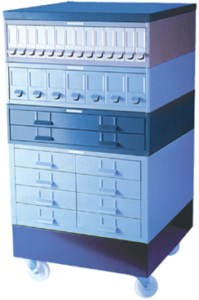In last month’s article, ‘Box Storage Utilities’, we discussed the primary containment material used in routine Histology laboratories, that of an organized cardboard box construction. We discussed, not only the economic benefits, but also strength and durability. Given the ever-present need for continuous archiving and the wear and tear that exists, one has to consider that the lifespan of storage may last for extended decades. This has caused a need in many laboratories to place priority on durability and longevity in their storage option selections.
Transitioning from the in-lab quick access storage of recently created blocks and slides, to a more fixed permanent to semi-permanent system can be a challenge and somewhat awkward initial adjustment. This requires giving up mobility of the unit and some degree of space. The two shelving images below demonstrate a system that eases the anxiety of that transition where you still have the feature of light weight cardboard, but housed in a heavy duty steel shelving system. The material is an 11-gauge steel casing that is built for stability and efficiency. It employs a pull-out and retractable shelf to create a live workstation when organizing the shelves. Furthermore, the steel units can be placed side-by-side to have continuous organization in a numeric system. This is ideal when deciding to dedicate a room or specific wall space for non-immediate access specimens. The far right shows the entire unit and the zoom image shows the workspace.


The next two images (to the right) demonstrate a ‘labstack’ design also made of heavy-duty steel. It is built with durability and longevity in mind, to have blocks and slides in the same unit. With the obvious weight of the construction material, along with the glass slides or blocks, one would perceive this to be a stationary unit that would not be moved. However, you can see from the far right image that a heavy duty wheeled base can be used to still allow mobility when needed. This unit also allows a smoother transition from the easy access cardboard storage that can be carried from one location to another in the main lab. With this feature the steel unit can’t be carried, but it can be rolled to more fixed and permanent area.


Finally, this last storage option discussed is also designed to maintain the option of on-site long-term storage, however, due to its immense capacity, it is optimally designed for a dedicated room or area outside of the general lab. The High-Density Storage Cabinet is considered the flagship of block and slide storage. It is a permanent, heavy-duty metal cabinet system designed for safe storage, immediate archive/retrieval of specimen, and security. It features full suspension drawers with a 400-pound load capacity to allow full viewing access to drawers and has an anti-tipping safety feature that only allows one drawer to be opened at a time. Given that these units might be stored in a private space or room where there might be limited monitoring, it also features a unique central locking mechanism to ensure authorized access and enhance regulatory laws on privacy (HIPAA). These units are highly favored in physician’s office facilities where immediate access is desired. It is considered a far more organized and efficient filing system with an aesthetic professional appearance.

As previously mentioned, these three options are presented primarily to show the choices that manufacturers have created when laboratories are transitioning from a simple organized storage, to a system with specific personalized features. Features that will accommodate extensive long-term storage with no defined period (decades), but allow immediate specimen access capabilities. A system that is designed to endure time and elements in its storage ability. Contact your local Lab Storage Systems consultant for more information on these or other options.

References:
- Brown, S., “The Economy of Storage”, Labstore Highlights, 2021.
- Dimenstein, I., “Specimen Storage in the Surgical Pathology Laboratory”, Gross Pathology, 2020.
- HIPAA Privacy Rule, https://www.hhs.gov/hipaa/for-professionals/privacy/index.html.
- www.labstore.com
